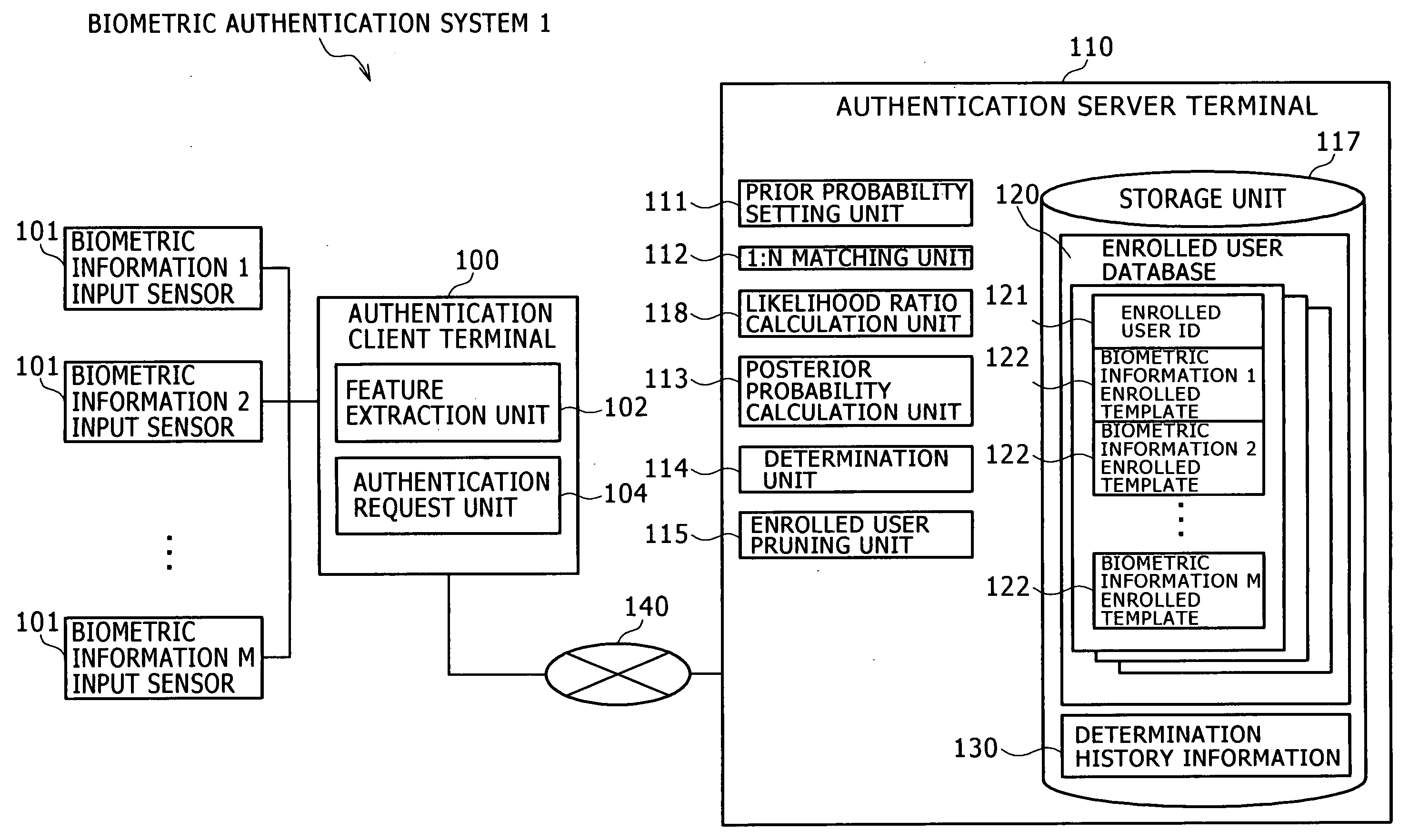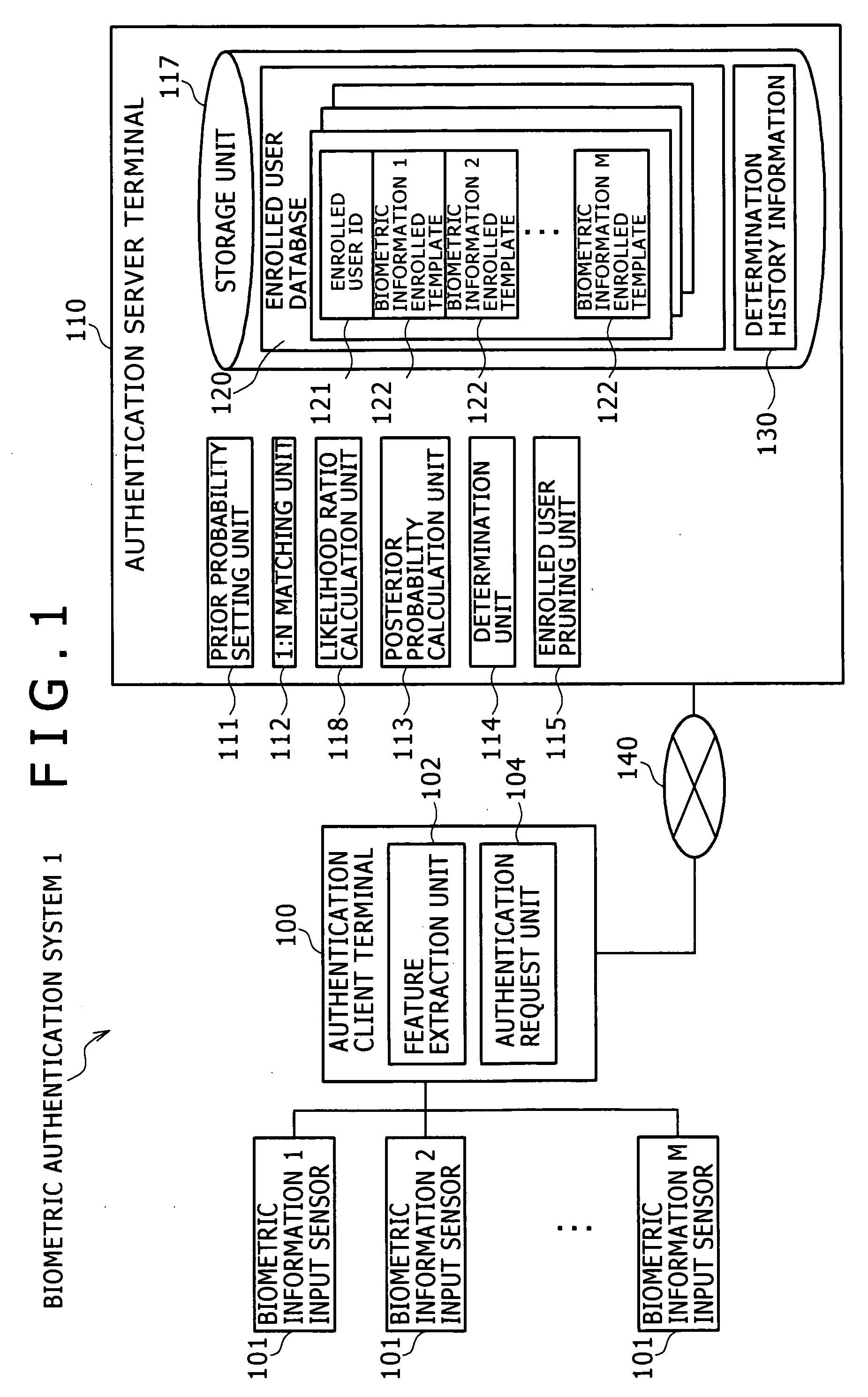Biometric authentication system, authentication client terminal, and biometric authentication method
a biometric authentication and client terminal technology, applied in the field of biometric authentication systems, can solve the problems of malicious users, no logical guarantee for minimizing the expected value of the number of inputs of biometric data necessary for determination, etc., and achieve the effect of improving the expected value of reducing the number of inputs
- Summary
- Abstract
- Description
- Claims
- Application Information
AI Technical Summary
Benefits of technology
Problems solved by technology
Method used
Image
Examples
first embodiment
[0046]A biometric authentication system 1 of this embodiment is a biometric authentication system that performs biometric identification between a claimant v and N enrolled users un (n=1 to N), using plural biometric data. The claimant is a user to be identified through an authentication client terminal 100. The enrolled user is a user whose feature data of the biometric data is previously registered for the purpose of matching.
[0047]FIG. 1 shows an example of the configuration of the biometric authentication system 1. The biometric authentication system 1 includes the authentication client terminal 100 and an authentication server terminal 110. The authentication client terminal 100 acquires the feature data from the biometric data of the claimant v, and presents the information such as the authentication result to the claimant v. The authentication server 110 performs biometric identification or other processing. The authentication client terminal 100 and the authentication server...
second embodiment
[0114]In this embodiment, authentication is performed using plural different types of biometric information belonging to the same modality. The second embodiment will be described below focusing on the difference from the first embodiment.
[0115]In step S307 of FIG. 3, the 1:N matching unit 112 of the authentication server terminal 110 performs 1:N matching between the claimant feature data extracted by the feature extraction unit 102 of the authentication client terminal 100, and M enrolled templates 122 held in the enrolled user database 120 with respect to each of N enrolled users un. Then, the 1:N matching unit 112 calculates the matching score sjnm of the m-th enrolled template with respect to each of the enrolled users un. In the following description, the distance in the feature space is used as the method for calculating matching scores. In this case, the smaller the matching score the better. In other words, the smaller the matching score, the more two biometric information ...
third embodiment
[0124]A biometric authentication system 2 of this embodiment is a cardless credit payment system. The third embodiment will be described below focusing on the difference from the first embodiment.
[0125]FIG. 7 shows an example of the configuration of the biometric authentication system 2.
[0126]A loss calculation unit 102a calculates a loss W1 occurring when v is a enrolled user and is identified as another enrolled user, and a loss W0 occurring when v is a non-enrolled user and is identified as a certain enrolled user, based on the price Q of a product the claimant v purchased.
[0127]A prior probability initial setting unit 111a initializes the posterior probabilities of the enrolled users un and the posterior probability of the non-enrolled user u0.
[0128]A prior probability and threshold setting unit 111b sets the prior probability of each of the enrolled users un and a corresponding threshold, as well as the prior probability of the non-enrolled user u0 and a corresponding threshold...
PUM
 Login to View More
Login to View More Abstract
Description
Claims
Application Information
 Login to View More
Login to View More - R&D
- Intellectual Property
- Life Sciences
- Materials
- Tech Scout
- Unparalleled Data Quality
- Higher Quality Content
- 60% Fewer Hallucinations
Browse by: Latest US Patents, China's latest patents, Technical Efficacy Thesaurus, Application Domain, Technology Topic, Popular Technical Reports.
© 2025 PatSnap. All rights reserved.Legal|Privacy policy|Modern Slavery Act Transparency Statement|Sitemap|About US| Contact US: help@patsnap.com



